Tom's Hardware Verdict
The Trident Z5 RGB DDR5-6400 C32 is great for DIYers who want to build a compact workstation with access to only two DIMM slots and need a lot of fast memory.
Pros
- +
Enormous capacity
- +
Strong performance
- +
Fairly priced
Cons
- -
Lacks AMD EXPO support
Why you can trust Tom's Hardware
Making the list of best RAM is challenging, but G.Skill’s Trident Z5 RGB DDR5-6400 C32 makes an excellent case. Mini-ITX and some microATX motherboards only come with two memory slots, making SFF (small form factor) enthusiasts lose half of the total potential memory capacity. DDR5 has somewhat leveled the playing field as the standard’s enhanced density per memory module makes it possible to achieve large quantities of memory on a motherboard with only two memory slots. Memory manufacturers have launched 96GB (2x48GB) memory kits, such as the G.Skill one in this review. That’s not the ceiling since there have already been demonstrations of 64GB DDR5 memory modules, pushing the limit to 128GB (2x64GB) on dual-DIMM motherboards. However, that’s a topic for another day.



The Trident Z5's design has remained static since its launch. It's an attractive design; therefore, G.Skill doesn't see any need to alter it one bit. However, the brand added a third color selection to the mix. So, Trident Z5 memory kits now come in white, metallic silver, and matte black colors. The aluminum heat spreader sticks to the prominent wing-like design with a corresponding black aluminum strip in the center. Trident Z5 memory modules are 42mm (1.65 inches) in height, so they're halfway between compact and tall memory.
G.Skill sells the Trident Z5 with and without RGB lighting. The latter variant logically features a translucent light bar over the heat spreader for extra pizzazz. You can control the memory module's illumination in two ways: You can download Trident Z Lighting Control software from G.Skill's website and use that or the software that came with your motherboard. Trident Z5 memory modules play nice with Asus Aura Sync, Gigabyte RGB Fusion 2.0, MSI Mystic Light Sync, and ASRock Polychrome.


The memory modules feature a dual-rank design with 16 integrated circuits (ICs). There are eight 3GB ICs on each side. For this SKU, G.Skill uses SK hynix's H5CGD8MEBDX021 (M-die) ICs. While the first DDR5 memory kits primarily leveraged Renesas power management ICs (PMICs), we see Richtek becoming the most used vendor. The PMIC on these Trident Z5 memory modules is the 0P=AE RG1 unit from Richtek.
If left in stock settings, the memory will run at DDR5-5600, a bit higher than your typical module that defaults to DDR5-4800. The timings will be at 46-45-45-90 timings. AMD EXPO support is absent, but there is XMP 3.0 support. The only profile embedded into the memory modules corresponds to DDR5-6400, with the timings and DRAM voltage configured to 32-39-39-102 and 1.35V, respectively. See our PC Memory 101 feature and How to Shop for RAM story for more timings and frequency considerations.
Comparison Hardware
Memory Kit | Part Number | Capacity | Data Rate | Primary Timings | Voltage | Warranty |
|---|---|---|---|---|---|---|
TeamGroup T-Force Delta RGB | FF3D532G7200HC34ADC01 | 2 x 16GB | DDR5-7200 (XMP) | 34-42-42-84 (2T) | 1.40 | Lifetime |
G.Skill Trident Z5 RGB | F5-7200J3646F24GX2-TZ5RK | 2 x 24GB | DDR5-7200 (XMP) | 36-46-46-115 (2T) | 1.35 | Lifetime |
Corsair Dominator Titanium First Edition | CMP64GX5M2X6600C32FEW | 2 x 32GB | DDR5-6600 (XMP) | 32-39-39-76 (2T) | 1.40 | Lifetime |
Kingston Fury Renegade | KF564C32RSK2-96 | 2 x 48GB | DDR5-6400 (XMP) | 32-39-39-80 (2T) | 1.40 | Lifetime |
G.Skill Trident Z5 RGB | F5-6400J3239F48GX2-TZ5RW | 2 x 48GB | DDR5-6400 (XMP) | 32-39-39-102 (2T) | 1.35 | Lifetime |
Corsair Vengeance | CMK192GX5M4B5200C38 | 4 x 48GB | DDR5-5200 (XMP) | 38-38-38-84 (2T) | 1.25 | Lifetime |


The Intel system runs the Core i9-13900K on the MSI MEG Z690 Unify with the 7D28v1G firmware. In contrast, the AMD system pairs the Ryzen 7 7700X with the MSI MPG X670E Carbon WiFi updated to the 7D70v1E5 firmware. The Corsair CUE H100i Elite LCD liquid cooler keeps our Raptor Lake and Zen 4 processor operating temperatures under check.
The MSI GeForce RTX 4080 16GB Gaming X Trio tackles the more graphics-intensive workloads, ensuring that there isn't a graphics bottleneck in our gaming RAM benchmarks. The Windows 11 installation, benchmarking software, and games reside on Crucial's MX500 SSDs. Meanwhile, the Corsair RM1000x Shift ATX 3.0 power supply provides our systems with clean and abundant power, directly feeding the GeForce RTX 4080 with a native 16-pin (12VHPWR) power cable. Lastly, the Streacom BC1 open-air test bench is vital to organizing our hardware.
Get Tom's Hardware's best news and in-depth reviews, straight to your inbox.
Component | Intel System | AMD System |
|---|---|---|
Processor | Intel Core i9-13900K | AMD Ryzen 7 7700X |
Motherboard | MSI MEG Z690 Unify | MSI MPG X670E Carbon WiFi |
Graphics Card | MSI GeForce RTX 4080 16GB Gaming X Trio | MSI GeForce RTX 4080 16GB Gaming X Trio |
Storage | Crucial MX500 500GB, 2TB | Crucial MX500 500GB, 2TB |
Cooling | Corsair iCUE H100i Elite LCD | Corsair iCUE H100i Elite LCD |
Power Supply | Corsair RM1000x Shift | Corsair RM1000x Shift |
Case | Streacom BC1 | Streacom BC1 |
Intel Performance









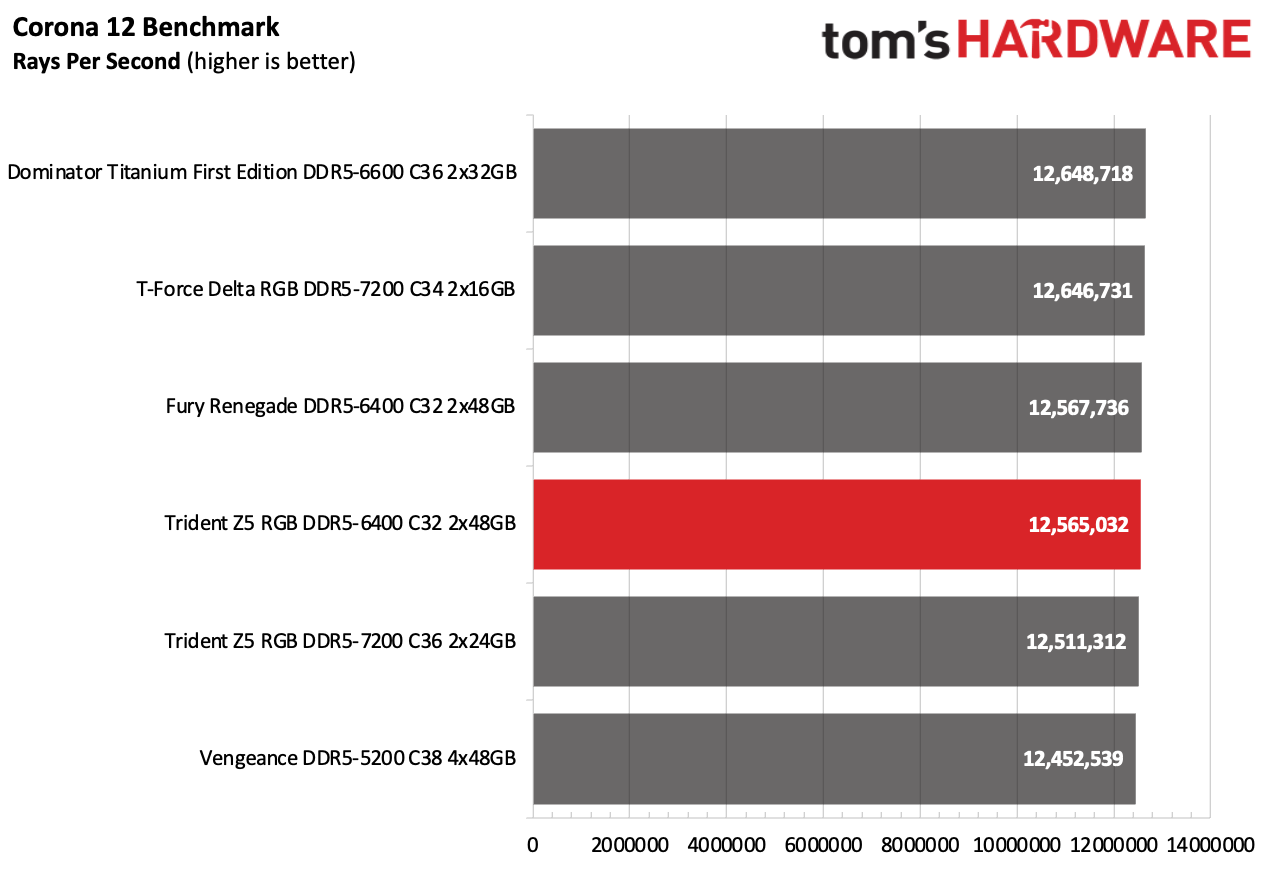










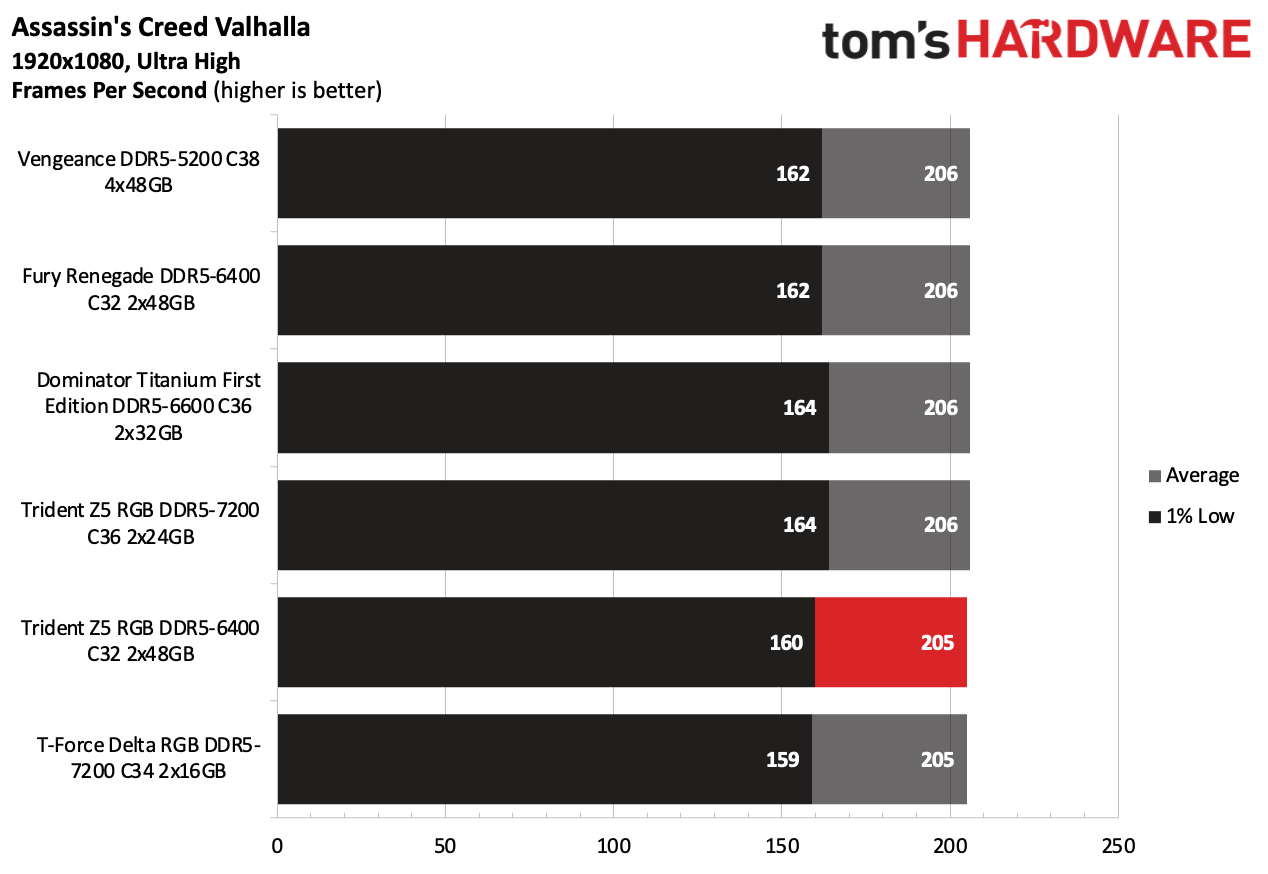
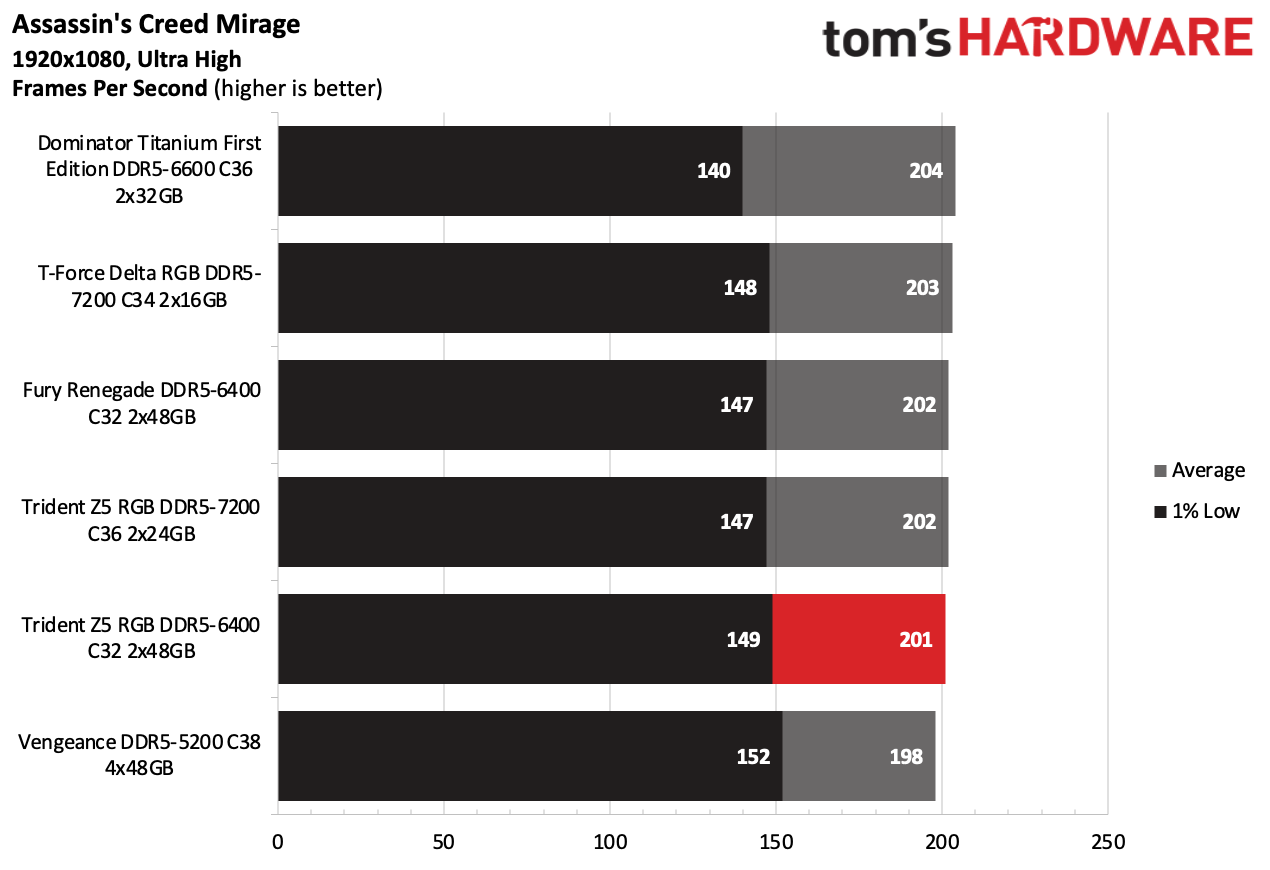

The Trident Z5 RGB was faster than the Fury Renegade in application performance, which shares somewhat similar specifications. The memory kit's best performance was in Adobe Premiere, where capacity triumphed over frequency. Other notable highlights of G.Skill's memory kit included Blender 4.0 and LuxMark V4.
AMD Performance







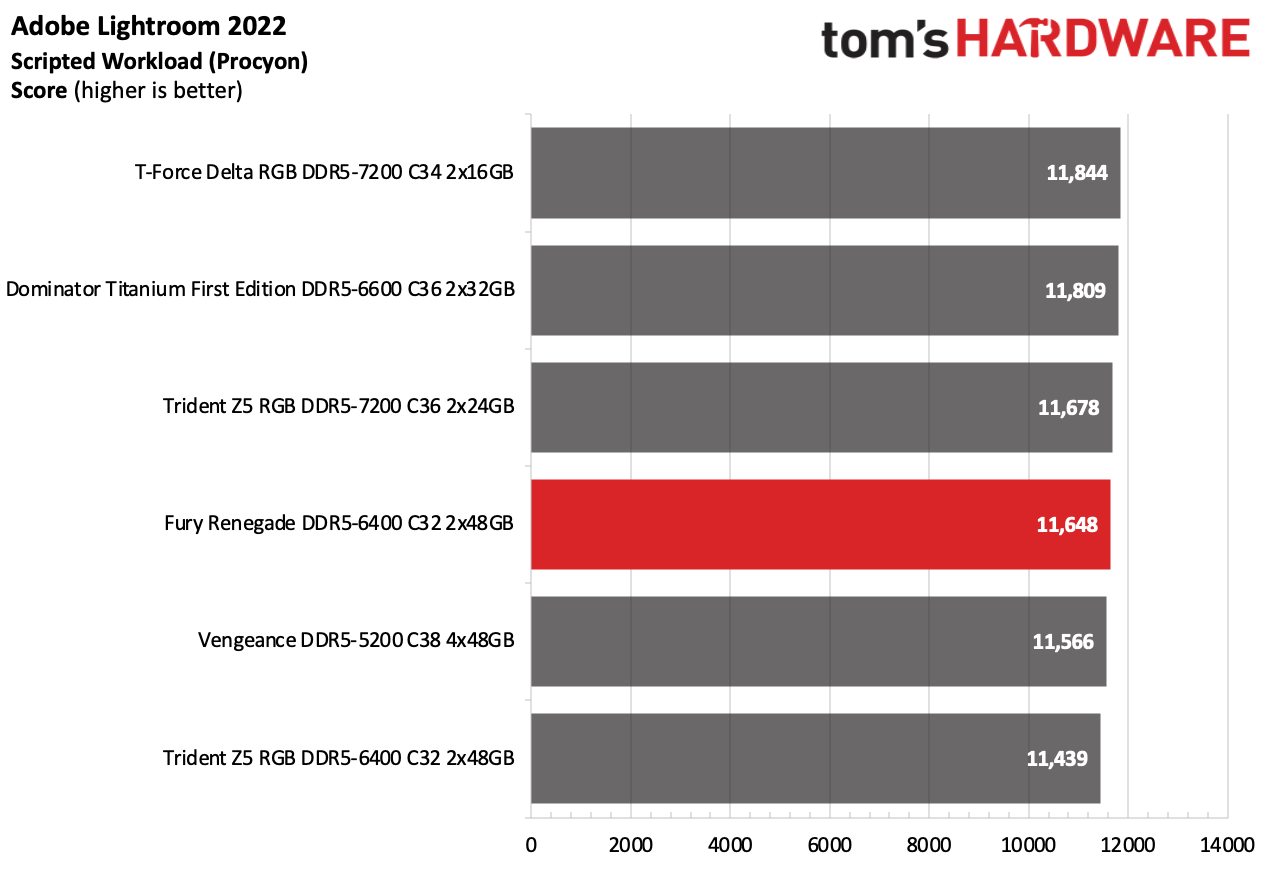
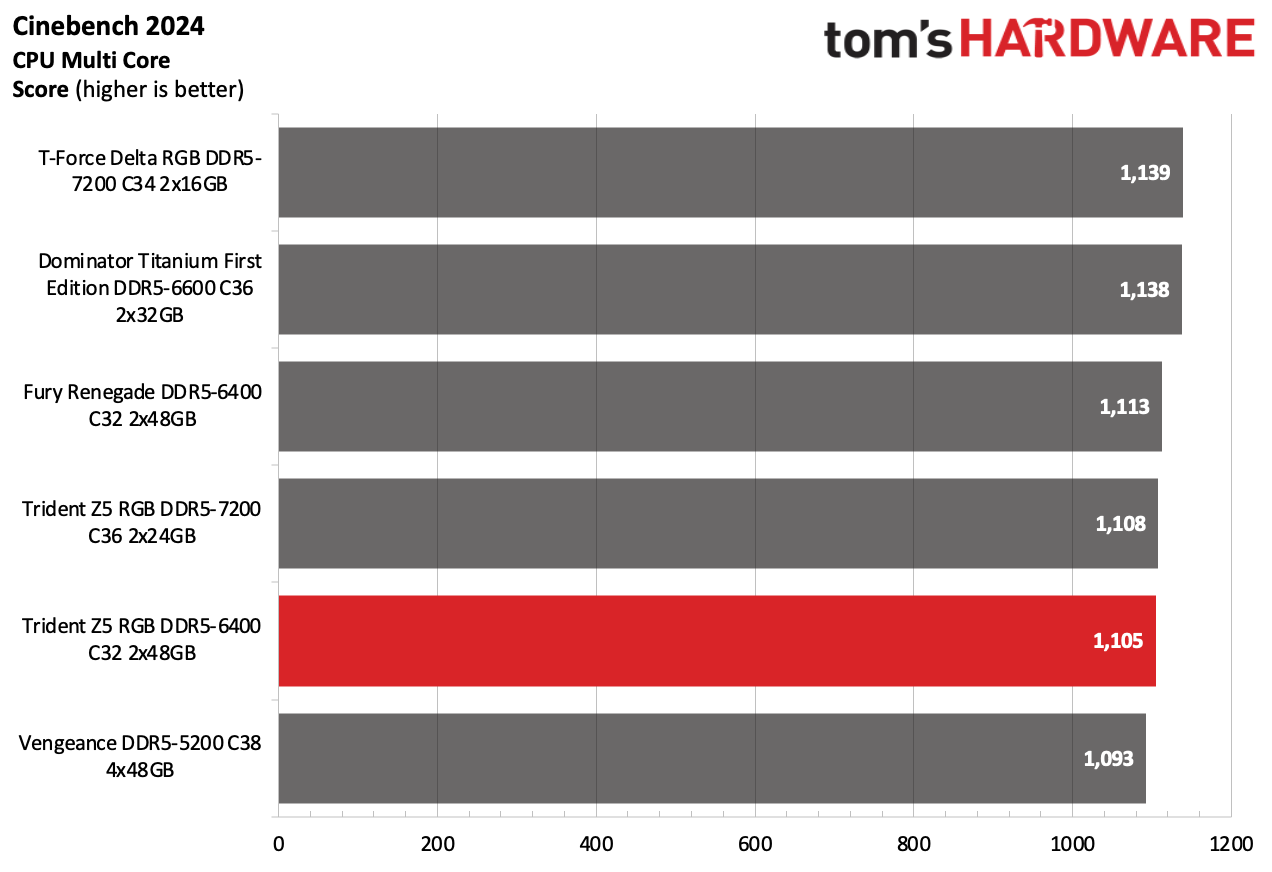
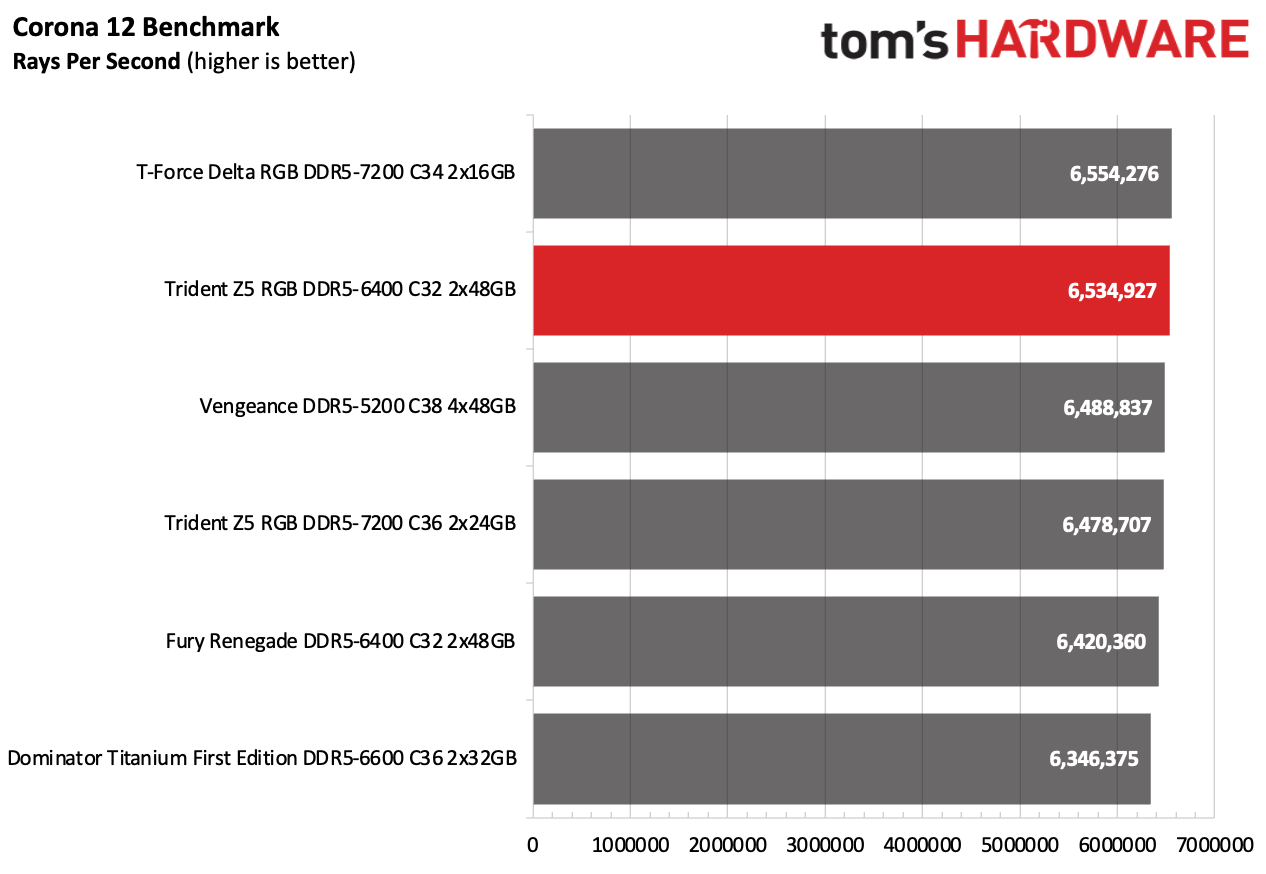













In contrast, the Fury Rengade outperformed the Trident Z5 RGB in application performance on the AMD platform. However, the latter was once again the best-performing memory kit in the Adobe Premiere benchmark.
Overclocking and Latency Tuning



Both memory kits utilize SK hynix M-die ICs, so we obtained similar overclocking results. Like the Fury Renegade, we pushed the Trident Z5 RGB to DDR5-6800 by increasing the DRAM voltage to 1.45V. Lowering the tRAS from 102 to 80 was also possible to equal that of the Fury Renegade.
Lowest Stable Timings
Memory Kit | DDR5-6400 (1.45V) | DDR5-6800 (1.45V) |
|---|---|---|
G.Skill Trident Z5 RGB DDR5-6400 C32 | 30-36-36-80 (2T) | 32-39-39-80 (2T) |
Kingston Fury Renegade DDR5-6400 C32 | 30-36-36-80 (2T) | 32-39-39-80 (2T) |
We also had a similar experience when optimizing the Trident Z5 RGB's memory timings at DDR5-6400. With a 1.45V DRAM voltage, we could run the exact timings (30-36-36-80) as the Fury Renegade.
Bottom Line
There has been a proliferation of 96GB DDR5 memory kits on the market, so the competition is tough in that category. Nonetheless, the Trident Z5 RGB DDR5-6400 C32 has demonstrated to be a strong option for motherboards with only two memory slots. Checking in at DDR5-6400, the memory kit delivers what many will consider performance within the widely accepted sweet spot while offering 96GB of capacity for multitasking and professional environments. Contenders in this category aren't cheap, but G.Skill has done well with the pricing of its memory kit.
96GB memory kits start at $235 but involve baseline speeds, such as DDR5-4800, so you lose a fair bit of performance. If you want something more high-end, the Trident Z5 RGB DDR5-6400 C32, which retails for $339.99, is hard to pass over. While it trades blows with the Fury Renegade DDR5-6400 C32, G.Skill's memory kit is $50 less expensive. It's a fantastic price for a DDR5-6400 memory kit with 96GB of capacity, as it is only bested by G.Skill's similarly specced Ripjaws S5 memory kit, which is $10 cheaper.
- MORE: Best RAM
- MORE: DDR DRAM FAQs And Troubleshooting Guide
- MORE: All Memory Content

Zhiye Liu is a news editor, memory reviewer, and SSD tester at Tom’s Hardware. Although he loves everything that’s hardware, he has a soft spot for CPUs, GPUs, and RAM.
-
35below0 Why is the lack of AMD EXPO listed as a con, when G.Skill have a Trident line dedicated solely to AMD EXPO kits?Reply
Technically it's a reason not to buy the kit so fair enough, but it's also logical that a non-EXPO kit would not have EXPO support.
